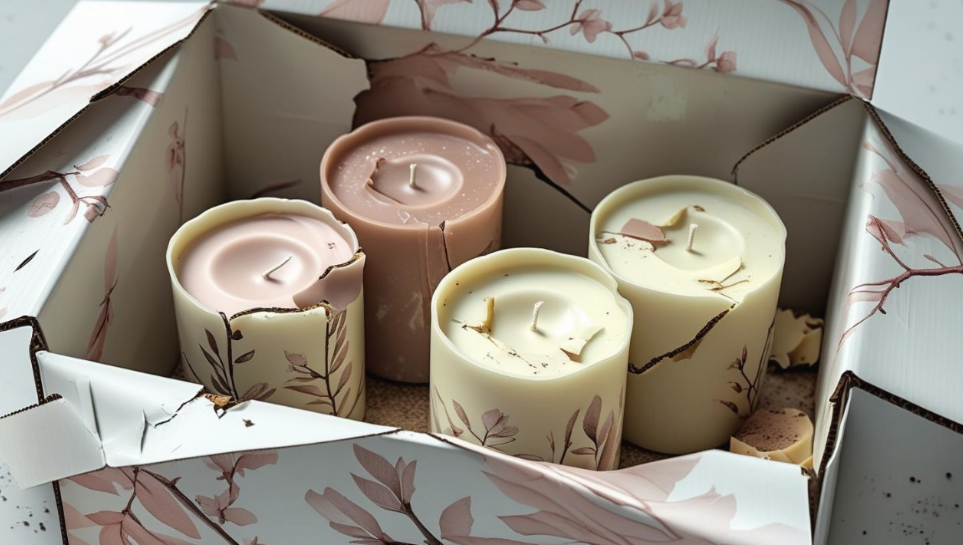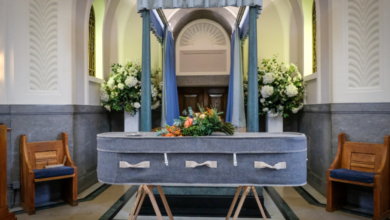
The Importance of Custom Candle Boxes in Reducing Shipping Damage
Cracked jars, warped wax, and scuffed labels: these are the ways customers do not want to receive their artisan candles.
And it’s not always about receiving a refund or an exchange, which most suppliers would happily do. It is about customers feeling disappointed after waiting for their order, about them having to go through the complaint and return process, and then needing to wait again.
On the other end, it is about the supplier hoping for a successful income and a good review, and receiving a complaint and a refund request along with the financial loss of a faulty item. Every damaged unit means money lost, time spent on replacements, and reputational strain across your supply chain.
Almost all of this trouble can be avoided through one strategic decision, i.e., candle boxes.
A well-designed candle box that provides reliable structural support and weight distribution and can withstand the pressures of transport, stacking, and storage can make a huge difference to a company’s supply chain efficiency.
This article explores how purpose-driven packaging reduces product damage, the materials and design decisions that make the difference, and the cost-saving benefits of doing it right.
How and Why are Candles Prone to Damage?
Candles are beautiful and evoke a number of sensory responses in beholders, but they are also delicate and typically sensitive to their surroundings. Because they are so sensitive, they are particularly susceptible to damage during shipping, where environmental changes can impact their appearance and/or functionality.
But how exactly is the shipping processes challenging for fragile items such as candles? Just to be clear, shipping involves every movement of the object from various points to get the product from the manufacturing facility to the customers. There are several things that can go wrong:
- Workers mishandling the products, leading to damage
- Compression in vehicles under larger, heavier packages
- Higher / mismanaged temperatures cause the candles to melt
- Carelessly loaded delivery vehicles, coupled with irresponsible driving, can cause packaging to move and collide with each other, possibly damaging each other.
- Rough handling and careless deliveries lead to battered boxes with disappointing presentation.
This is not an exhaustive list, but it definitely gives a fair idea of the several ways candles can be damaged during transit. The table below presents how different types of candles can be damaged:
| Type of Candle | Possible Damage | Explanation |
| Glass Jar Candles | Glass Breakage | Glass containers crack or shatter from impact, dropping, or stacking pressure during handling |
| Simple Pillar Candles | Breakage WarpingMelting | Vulnerable to pressure damage, temperature-induced shape distortion, and heat-related melting |
| Artisan / Handmade Candles | Breakage WarpingMelting | Delicate craftsmanship makes them susceptible to physical damage and temperature changes |
| Tinned Candles | DistortionMelting | Metal containers dent under pressure; confined space increases the risk of melting from heat |
How Can Custom Candle Boxes Help Protect Candles?
Custom candle boxes reduce shipping damage because they’re made to fit, not force the product. When the box structure matches the candle’s size and shape, there’s no excess space for movement, and no tight pressure that could crack the glass or warp the wax. That exact fit is what prevents shifting and breakage during handling or transit.
Additionally, personalized packaging allows you to choose the proper board strength depending on the weight of the candle. The heavier the jar, the higher-quality base and reinforced walls it requires. The thinner profile taper candle would probably be better off with protective box inserts that hold it in place. They are not one-size-fits-all.
See also: Lifeguard training: The Key to Respecting Water and Preventing Drowning
1) Choosing the Right Type of Candle Boxes
i) Folding Cartons/Cardboard Boxes
They are lightweight solutions designed primarily for individual product packaging and retail display. These boxes work well for on-shelf presentation but require additional protection for shipping. When used for online deliveries, folding cartons must be placed inside corrugated shipping boxes with supplementary padding such as air padding or shredded kraft paper to prevent damage during transit.
ii) Rigid Candle Boxes
These offer premium protection for both individual and multi-pack candle packaging. Their sturdy construction provides excellent structural integrity, making them ideal for presenting luxury candles. However, while sleek in design, rigid boxes must be paired with proper inner padding to manage weight and vibration. Like folding cartons, these boxes require placement in corrugated shipping containers with additional protective materials for safe online delivery.
iii) Corrugated Candle Boxes
Corrugated custom candle boxes represent one of the most versatile options.
One of the most significant benefits of using corrugated boxes is that brands can uniquely design the box material themselves. This is achieved by selecting the appropriate type of fluting, the number of fluting layers, and the type of liner board.
Double-wall corrugation, for instance, minimizes the chances of bending or collapsing while in transportation if you are shipping large orders or heavy jars. By customizing their base construction, corrugated packaging can be transformed into individual packaging, multi-pack containers, and shipping boxes quite easily.
Corrugated board is a reliable and proven box material choice for capacity and weight customization. Their fluted construction not only provides inherent shock absorption and structural strength, but it also provides higher edge crush resistance, which helps during stacking and pressure from other packages.
As mentioned above, both folding cartons and rigid candle boxes need corrugated outer packaging for the warehouse-to-store transit and even for online deliveries. On the other hand, corrugated packaging solutions can be applied to all kinds of uses. Therefore, while folding cartons and rigid boxes are adequate in retail operations, corrugated boxes offer the flexibility to be cost-effectively reversed from the warehouse to the customer’s doorstep.
The following table presents an overview of corrugated materials and their use:
| Material Type | Strength Under Pressure | Moisture Resistance | Suitable for |
| Single-wall Corrugated Boxes | Moderate | Low | Light candles, short-distance shipping |
| Double-wall Corrugated Boxes | High | Moderate | Heavy jars, long-distance or bulk orders |
iv) Custom Boxes with Inserts
The importance of box inserts when it is comes to fragile items such as candles cannot be overstated. Box inserts can include (but are not limited to) elements like:
- Die-cut cardboard/paperboard partitions within the box
- Foam or corrugated inserts between or on the top and bottom of the items to absorb impact
- Bubble wrap, kraft paper or corrugated sheet individually wrapping the delicate items (without causing damage)
- Bubble wrap or Airpadding tightly snuggling the free spaces within items (if any) or between the product box and the shipping box for added protection.
Explore the different options brands have when it comes to protective and aesthetic box inserts here: https://themailerbox.com/custom-inserts/
Internal supports like corrugated partitions or foam inserts keep the candle centered and cushioned. Box inserts can help resist impact to candles and also reduce surface friction that can keep the delicate artisan candles intact for a perfect unboxing moment.
- Box Designs that Protect and Present
The way a candle box is built affects how well it protects what’s inside. Weak flaps, loose folds, and shallow closures expose the product to crushing and impact. A solid structure acts as a buffer between the candle and any potential damage during shipping.
In the world of custom packaging, the options of box designs available to meet your candles’ precise needs are limitless. So, if you’re a small-to-medium-sized candle box, read more about how the right candle box can help you compete with big brands here: https://themailerbox.com/Blog/candle-boxes-for-small-candle-makers/
- Crafting Print Design for Operational Efficiency
Strategic print design on candle boxes serves as a communication system that guides handlers throughout the shipping process, directly reducing damage rates and improving operations. For example, “Fragile” and “This Side Up” markings aren’t just suggestions but damage prevention tools.
Bold “Fragile” labels near corners catch attention during lifting, while
“This Side Up” arrows prevent candles from traveling upside down, which can negatively affect weight distribution, product presentation, and increase the risk of damage.
Product handling instructions printed on boxes eliminate the need for guesswork. Simple graphics showing proper lifting points or stacking limitations help prevent crushing or dropping. These visual cues work across language barriers in fast-paced shipping environments.
Similarly, return instructions integrated into the box design streamline reverse logistics in the event of damage. Clear return addresses, QR codes for return portals, and step-by-step procedures printed on inner flaps reduce customer frustration and processing time, turning negative experiences into manageable ones.
When incorporating printing design targeting building operational efficiency, it is important to understand that well-designed packaging includes designated spaces for shipping labels and warnings. Simply stated, if handling instructions or directional arrows are not easily or effectively visible, the protective messaging becomes useless.
Finally, the aesthetics of candle boxes also depend a lot on the printing techniques. This includes the color scheming, the print and logo placement on the box, as well as the finishes. Regarding the reduction of shipping damage, the finish plays a crucial role in maintaining the visual appeal and structural integrity of the candle box itself. For example, matte or gloss lamination helps seal the surface, reducing scuff marks, moisture absorption, and dirt buildup. A protective finish also keeps printed details intact, so branding remains clear and unblemished on arrival.
Conclusion
If you’re using custom candle boxes, precision is already part of the design. You decide the depth, width and lid tension specifically based on your product. Custom packaging ensures a more consistent shipping process, both visually and structurally, something that is critical for brands operating in the candle manufacturing or branding industry.
When your candle box is well-built, designed to fit, and made to last through transit, damage is reduced, and so are complaints. Brands can avoid waste, reduce returns, and meet client expectations with minimal but strategically directed effort.
A candle box that fits right performs better, every time.




